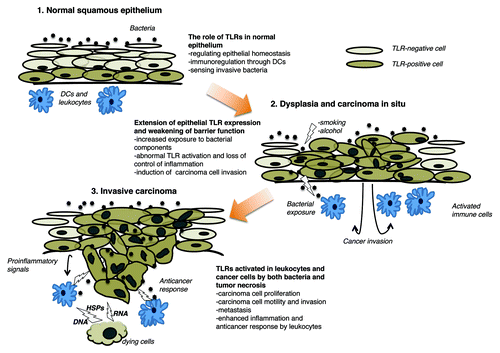Figures & data
Figure 1. Effects of Toll-like receptors in the squamous epithelium. Bacteria do not penetrate the normal epithelium and contribute to epithelial homeostasis. In this setting, bacterial components are recognized by dendritic cells (DCs), which can limit inflammatory response. Conversely, invasive bacteria are sensed by Toll-like receptors (TLRs) expressed on both basal cells of the epithelium and inflammatory cells, hence inducing an inflammatory reaction. In the presence of known carcinogens such as tobacco and alcohol, the barrier function of epithelium is compromised and bacteria can penetrate. This is facilitated in the setting of carcinoma in situ, as the cellular and epithelial polarity are compromised and TLR expression extends to the whole epithelium. Such alterations allow for the activation of subepithelial cells, favoring invasiveness. In invasive carcinoma, bacterial components as well as endogenous TLR ligands released by dying cells activate both leukocytes and tumor cells. Carcinoma cells respond to TLR ligands by secreting pro-inflammatory cytokines, proliferating and exhibiting an invasive phenotype, whereas leukocytes do so by stimulating inflammation and killing malignant cells. DC, dendritic cell; HSP, heat-shock protein.
